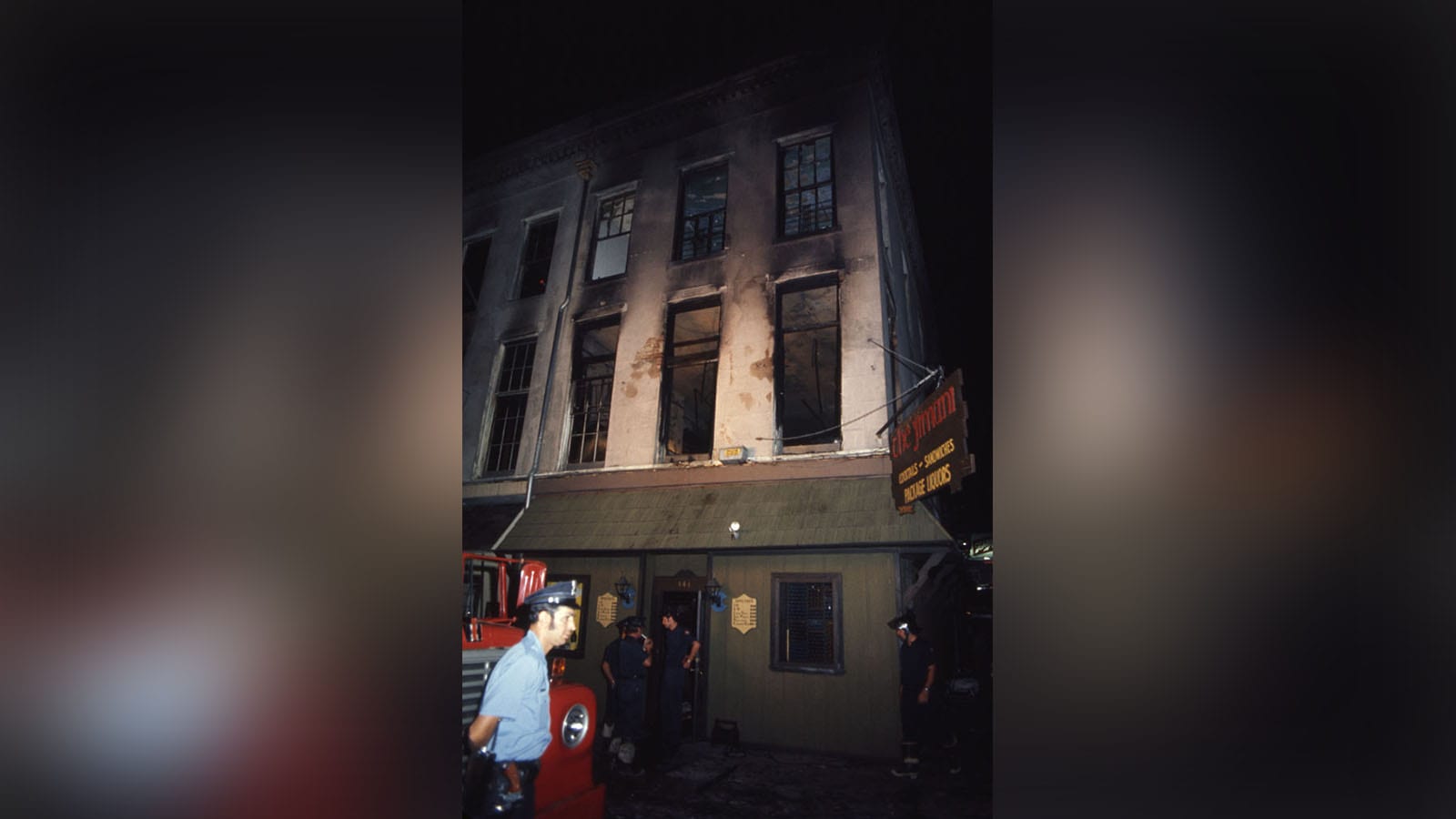June is LGBT Pride Month each year to commemorate the Stonewall riots, which occurred at the end of the month in 1969.
It was four years later, however — on the final day of Pride Weekend in 1973 — that one of the deadliest attacks on a gay club in American history took place in New Orleans.
If you walk through the French Quarter, you might be familiar with The Jimani — a bar at 141 Chartres St., on the corner of Chartres and Iberville. The Jimani is on the first floor of a three-story building, just like it was in 1973.
On the second floor at that time was a popular gay bar called the “UpStairs Lounge.”
At that time, nearly two dozen gay bars could be found around the French Quarter. UpStairs Lounge stood out by drawing regulars in with dancing, singing, live piano and a modest theater where small plays and musicals were staged.
The bar was also more inclusive than other gay bars in the Quarter. Like elsewhere in the country, Blacks and whites tended to frequent different establishments — even in the gay community. But, while the large majority of UpStairs’ patrons were white, they made a point to welcome African Americans (as well as lesbians, which was also uncommon at the time). The lounge’s unofficial anthem was the Brotherhood of Man’s 1970 hit, “United We Stand.” Patrons would gather around the piano from time to time and sing along to the chorus’ hopeful lyrics, “United we stand, divided we fall.”
Reginald Adams was one African American there on June 24, 1973. He was at the lounge with his partner, Ricky, who now goes by Regina. Realizing they didn’t have enough money with them for dinner, Regina made a quick trip home to grab some cash.
Reginald was hardly left alone, though. Besides it being the last day of Pride Weekend, it was Sunday evening and the UpStairs Lounge was hosting its weekly Sunday “Beer Bust” — a happy hour featuring all-you-can-eat-(and-drink) for $2.
Out of the 125 regular patrons that packed into the bar, about 60 stayed after the special ended. They were mostly members of the local Metropolitan Community Church — the local chapter of America’s first gay church. The congregation used UpStairs Lounge for religious services because their permanent church had been targeted and set ablaze several times in recent years.
The lounge was also used as a hangout. That evening, congregants were planning an upcoming fundraiser for Children’s Hospital, and — along with other regulars — they were listening to popular cocktail pianist David Gary perform.
View this post on Instagram
Tragedy
Just before 8 p.m., the downstairs buzzer sounded, signaling someone was at the door. Bartender Buddy Rasmussen asked regular Luther Boggs to check it out, expecting it to be a taxi driver.
When Boggs opened the door to the stairwell, he was met with a horrifying image: the stairwell was engulfed in rapidly approaching flames.
One survivor, Courtney Craighead, told the New Orleans States-Item the day after the fire that he believes a flammable liquid was used on the stairway. “The fire came up so fast,” he said. “There was an immense smoke in the room immediately.”
Panic overtook the bar as the five-dozen patrons realized they were in danger.
Rasumussen led what ended up being 20 patrons out the back exit to the roof, where the group could descend to the ground. Unfortunately, when the door closed, it locked the remaining patrons inside the bar.
The fire spread throughout the lounge, and those patrons saw the windows as the best means of escape. The problem: the window was covered by safety bars with only 14-inch gaps between each bar.
“I was small enough so I could get out,” explained Adolph Medina of San Antonio. “I was panicked about jumping but two guys urged me to jump and I was small enough. Some big guy on the ground caught me and I kept looking back but my friend never got out.”
Fire trucks from a station just three blocks away tried to reach the scene but were blocked by cars and pedestrian traffic. One truck tried to maneuver on the sidewalk but crashed into a taxi.
New Orleanians gathered on the street below the burning building, watching helplessly as victims attempted to free themselves from the inferno. Many were stuck inside, but even those who managed to escape, as Medina did, were not guaranteed safety.
The New Orleans States-Item from June 25 reported that many of the bodies were still on fire as they hit the ground. “The street and sidewalk were pools of blood and pieces of flesh from those who jumped,” the article read.
The Victims
When Regina returned to the UpStairs Lounge with money for dinner, it had become the scene of the deadliest fire in New Orleans history. Reginald was among the victims.
Once firemen finally reached the scene, they were able to quickly control the fire. It was extinguished by 8:12 p.m. — 16 minutes after it began. But it was too late.
The States-Item reported on June 26 that “of the 29 killed, 27 were men and two were women. Most of the bodies were stacked like pancakes next to a set of windows facing the corner of Iberville and Chartres streets next to a piano.”
In the end, the death total would rise to 32 individuals. Cocktail musician David Gary was one of them.
View this post on Instagram
Luther Boggs — who first noticed the fire — pushed his female friend through the gap in the bars and then followed her. He leaped from the building, himself in flames, before a neighboring bartender was able to extinguish them. Boggs clung to life for more than two weeks before succumbing to the third degree burns over 50% of his body.
The local chapter of the Metropolitan Community Church lost its reverend, Bill Larson as well as one-fourth of the 40-member congregation.
Larson removed an air conditioning unit from the bottom of one of the windows. He was attempting to escape through the space he created when a pane of glass from the window fell on him. His burnt remains were visible to onlookers for hours after the flames were extinguished resulting in some of the tragedy’s most horrific images.
MCC assistant pastor George Mitchell was able to escape, but ran back inside after realizing his partner, Louis Horace Broussard (who he considered his husband), was still inside. The two men were among the dead — their bodies found clinging to each other.
The Aftermath
A review of the articles from the days and weeks after the UpStairs Lounge tragedy appears that New Orleans and its leaders focused on fire safety improvements rather than the lives lost. There was no statement of sympathy from any elected official in Louisiana, including the mayor, Moon Landrieu. Roman Catholic Archbishop Philip Hannan stayed silent, as well.
Families of some of the victims refused to come forward and claim the bodies of the deceased, or to pay for their funerals — out of fear or embarrassment.
When the MCC attempted to hold a memorial service, they were hard-pressed to find a church willing to host them.
Morty Manford, a co-founder of the Gay Activist Alliance of New York City told the States-Item on July 2 that “we had been prepared to go out in the streets because we were turned down right and left by the Sunday Christians, who aren’t even Christians on Sunday.”
View this post on Instagram
Reverend William P. Richardson of St. George’s Episcopal Church was one leader who agreed to hold a small prayer service. He was rebuked the next day by the Episcopal bishop of New Orleans, Iveson B. Noland, who received more than 100 complaints from parishioners. Hate mail filled Richardon’s mailbox.
The day after the fire, Major Henry Morris, New Orleans’ chief of detectives, explained to the States-Item how difficult identification will be due to the extensive burns victims suffered. Still, he couldn’t resist taking a dig at the victims.
“We don’t even know if these papers belonged to the people we found them on,” Morris said. “Some thieves hung out there and you know this was a queer bar.”
Three days later, a reporter from the paper wrote that they overheard a woman saying, “I understand they could eat and drink all they wanted up there for $2 and Lord knows what other activities. The Lord had something to do with this. He caught them all in there and punished them.”
The press ran quotes from one local cab driver who said, “I hope the fire burned their dresses off,” and talk radio hosts allegedly told the following “joke”: “What will they bury the ashes of queers in? Fruit jars.”
The Case That Won’t Close
Within about a week, most investigators believed arson was the cause.
Today, most consider Robert Nunez — a gay man with a history of mental illness — to be the main suspect. Nunez was kicked out of the UpStairs Lounge earlier in the evening after a physical altercation with another patron. After the fire, the police tried to question Nunez, but he was unable to speak because of a broken jaw from the fight.
The police would later arrest Nunez, but he escaped from psychiatric custody and was never re-arrested.
A friend of Nunez’ said the man confessed several times to setting fire to the bar. He committed suicide in November 1974.
Remembering
The City of New Orleans failed to honor the memory of these 32 victims in 1973, but we don’t have to follow their lead. By learning and sharing the victims’ stories, and saying their names, we can make sure one of the deadliest attacks against the gay community in American history isn’t forgotten.
View this post on Instagram
Before the calendar turns on Pride Month, here are several ways to learn more about this tragedy:
Rent the documentary “UpStairs Inferno” from Amazon.com for just $3.99.
Here are the names of the 32 victims who had their lives senselessly cut short on June 23, 1973:
- Willie Inez Warren
- Eddie Hosea Warren
- James Curtis Warren
- Luther Boggs
- Rev. William R. Larson
- Dr. Perry Lane Waters, Jr.
- Horace “Skip” Getchell
- Leon Richard Maples
- George Steven “Bud” Matyi
- James Wall Hambrick
- Larry Stratton
- Joe William Bailey
- Clarence Joseph McCloskey, Jr.
- Adam Roland Fontenot
- Ferris LeBlanc
- Donald Walter Dunbar
- Kenneth Paul Harrington
- Gerald Hoyt Gordon
- John Thomas Golding, Sr.
- Douglas Maxwell Williams
- Robert “Bob” Lumpkin
- David Stuart Gary
- Guy D. Anderson
- Duane George “Mitch” Mitchell
- Louis Horace Broussard
- Reginald Adams, Jr.
- Joseph Henry Adams
- Herbert Dean Cooley
- Glenn Richard “Dick” Green
- Larry Norman Frost
- Unidentified White Male
- Unidentified White Male
Works Consulted:
The Tragedy of the Upstairs Lounge. https://www.thejimani.com/thehistoryof/theupstairslounge.html Accessed June 2020.
Southern Fried True Crime Podcast. Episode 55: The UpStairs Lounge Fire. https://www.southernfriedtruecrime.com.
“The Up Stairs Lounge Arson: Thirty-Two Deaths in a New Orleans Gay Bar, June 24, 1973” by Clayton Delery-Edwards.
Lind, Angus, et al. 29 Dead in Quarter Holocuast. 13 Fire Victims are Identified. New Orleans States-Item. June 25, 1973.
Thomas, Lanny. Have Labels Overshadowed 29 Deaths? New Orleans States-Item. June 28, 1973.







